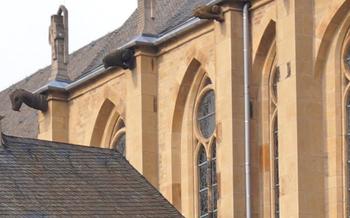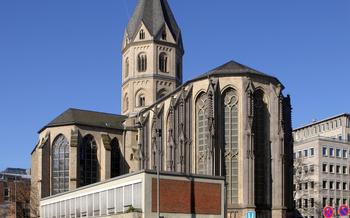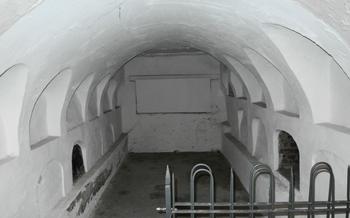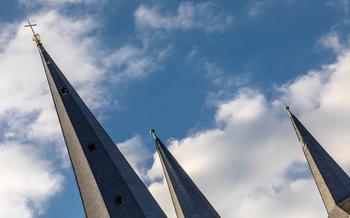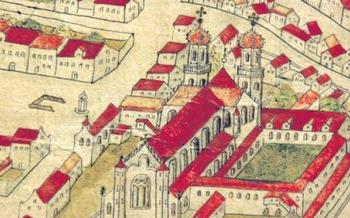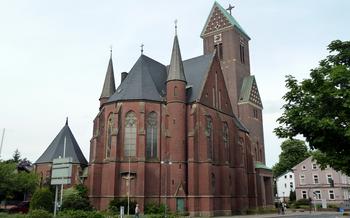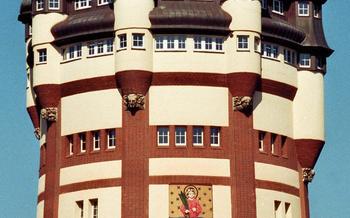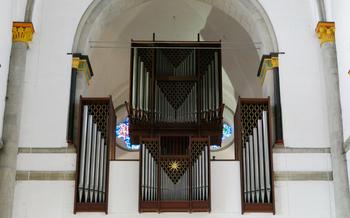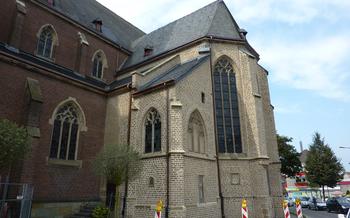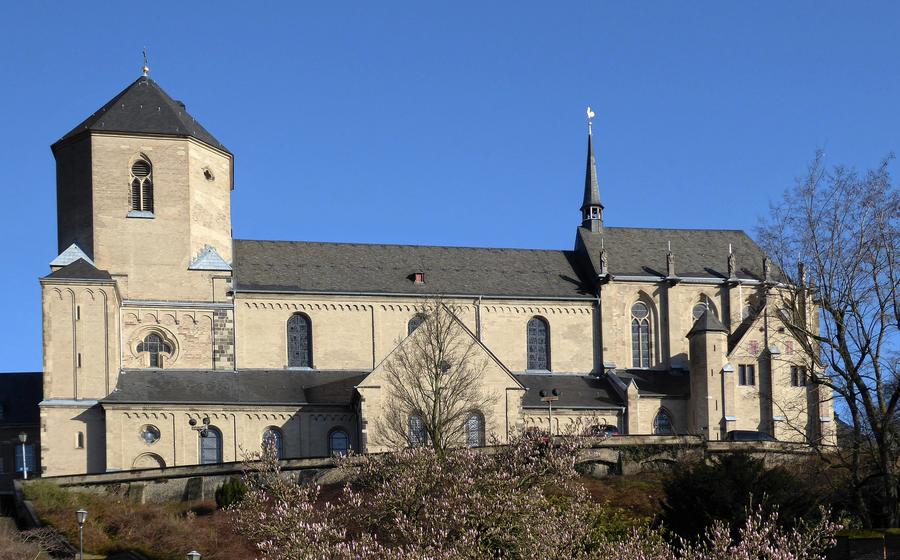
St. Vitus Basilica
- Historical Significance
- Architectural Masterpiece
- Interior Splendor
- Sacred Relics
- Pilgrimage Traditions
- Worship and Services
- Guided Tours
- Accessibility and Location
- Opening Hours and Admission
- Dress Code and Etiquette
- Photography and Videography
- Souvenirs and Religious Items
- Local Festivals and Events
- Nearby Attractions
- Insider Tip
Historical Significance
Standing as a testament to centuries of faith and devotion, the St. Vitus Basilica holds a profound historical significance in Mönchengladbach. Its roots can be traced back to the 10th century, making it the oldest church in the city. Initially constructed as a small chapel dedicated to Saint Vitus, the basilica has undergone several expansions and renovations over the centuries, reflecting the growing importance of the pilgrimage site. In 1948, Pope Pius XII bestowed upon it the prestigious title of minor basilica, further solidifying its status as a significant religious destination. Today, the St. Vitus Basilica remains a beloved landmark, drawing pilgrims and visitors from far and wide to experience its spiritual ambiance and rich history.
Architectural Masterpiece
The St. Vitus Basilica's architectural grandeur is a testament to the skill and artistry of medieval builders. Its Romanesque style, characterized by rounded arches and sturdy walls, creates a sense of solidity and permanence. The basilica's twin towers, rising proudly above the city skyline, serve as beacons of faith and devotion. The westwork, a distinctive feature of Romanesque architecture, adds depth and dimension to the basilica's façade, creating a dramatic entrance that invites visitors to step into a realm of sacred beauty.
The basilica's interior is equally impressive, with its three naves separated by massive pillars and topped by elegant ribbed vaults. These vaults, a marvel of medieval engineering, distribute the weight of the structure while creating a soaring sense of space. The basilica's construction incorporates local materials, such as tuff and limestone, adding to its sense of authenticity and connection to the region's history. Every element of the basilica's architecture, from the grand towers to the intricate carvings, reflects the devotion and craftsmanship of its builders, making it a true masterpiece of medieval architecture.
Interior Splendor
The interior of St. Vitus Basilica is a testament to the artistry and devotion of its creators. The basilica's richly decorated interior is a sight to behold, with its beautiful stained glass windows, impressive ceiling frescoes, and intricate carvings and sculptures adorning the walls and columns.
The stained glass windows, crafted by skilled artisans, depict biblical scenes with vibrant colors and intricate details. They illuminate the basilica with a warm and ethereal glow, casting a mystical aura upon the sacred space. The ceiling frescoes, equally impressive, showcase religious motifs and narratives, adding to the basilica's spiritual atmosphere.
The walls and columns of the basilica are adorned with intricate carvings and sculptures, each a masterpiece in its own right. These works of art depict saints, angels, and other religious figures, adding depth and dimension to the basilica's interior. The attention to detail and the skillful execution of these carvings are a testament to the dedication and artistry of the craftsmen who created them.
Together, the stained glass windows, ceiling frescoes, and carvings create a harmonious and awe-inspiring interior that invites contemplation and devotion. Visitors to the basilica are transported back in time, experiencing the beauty and majesty of medieval craftsmanship while immersing themselves in the sacred atmosphere of this historic pilgrimage site.
Sacred Relics
The St. Vitus Basilica's status as a significant pilgrimage site is closely linked to the presence of sacred relics, attracting countless believers from near and far. The basilica serves as the final resting place of Saint Vitus, a revered martyr who is greatly venerated throughout the Catholic world. His relics, believed to possess miraculous powers, have been enshrined within the basilica since the Middle Ages.
The presence of Saint Vitus's relics has transformed the basilica into a prominent pilgrimage destination, drawing thousands of faithful each year. Pilgrims come seeking divine intervention, healing, and spiritual guidance. The basilica's reputation as a site of miracles has led to numerous accounts of miraculous healings and answered prayers, further solidifying its status as a sacred and holy place.
In addition to Saint Vitus's relics, the basilica also houses several other sacred relics, each with its own unique story and significance. These relics, which include fragments of the True Cross and bones of various saints, serve as tangible reminders of the rich history and profound faith associated with the basilica.
Pilgrimage Traditions
The St. Vitus Basilica is renowned not only for its architectural splendor but also as a significant pilgrimage site. Every year, during the month of June, the city of Mönchengladbach comes alive with the annual Vitus Pilgrimage, a centuries-old tradition that attracts thousands of pilgrims from near and far.
The pilgrimage traces its roots back to the 14th century when the relics of Saint Vitus, the basilica's patron saint, were brought to Mönchengladbach. Since then, the city has become a center of devotion to Saint Vitus, and the pilgrimage has evolved into one of the most important religious events in the region.
The highlight of the pilgrimage is the grand procession, where the relics of Saint Vitus are carried through the streets of Mönchengladbach. Thousands of pilgrims, dressed in traditional costumes, join the procession, creating a spectacle of faith and devotion. The procession is accompanied by music, prayers, and the waving of colorful flags, adding to the festive atmosphere.
During the pilgrimage, the city of Mönchengladbach transforms into a vibrant hub of spiritual and cultural activities. Pilgrims and visitors alike participate in masses, prayer services, and processions, seeking blessings and spiritual renewal. The pilgrimage is also a time for celebration, with local markets, food stalls, and entertainment adding to the festive spirit.
The Vitus Pilgrimage is not just a religious event but also a testament to the deep-rooted traditions and cultural heritage of Mönchengladbach. It is a time for the community to come together, celebrate their faith, and honor the legacy of Saint Vitus, whose relics continue to inspire hope and devotion among pilgrims from all walks of life.
Worship and Services
The St. Vitus Basilica serves as a central hub for worship and spiritual gatherings in Mönchengladbach. Regular masses and services are held throughout the week, offering a space for the local community and visitors to come together in prayer and contemplation. The liturgy and rituals conducted within the basilica follow the traditions of the Catholic Church, creating a sacred and reverent atmosphere. Attending a service at the basilica provides a unique opportunity to witness the devotion and faith of the local congregation while experiencing the spiritual energy that emanates from this historic site. Visitors are welcome to participate in the services, immersing themselves in the local religious practices and gaining a deeper understanding of the basilica's significance as a center of worship.
Guided Tours
Enhance your visit to the St. Vitus Basilica by embarking on a guided tour, an enriching experience that delves deeper into the basilica's history, architecture, and religious significance. Knowledgeable guides, passionate about the basilica's heritage, bring to life the stories and symbolism embedded within its walls.
General tours provide a comprehensive overview of the basilica, highlighting its architectural features, sacred relics, and pilgrimage traditions. Specialized thematic tours, on the other hand, offer a more in-depth exploration of specific aspects, such as the basilica's art and iconography, its role in local history, or its significance as a pilgrimage site.
To ensure a spot on a guided tour, advance booking is recommended, especially during peak tourist season. Check the basilica's official website or contact the parish office for tour schedules and availability. Group tours can be arranged for larger parties, offering a tailored experience for pilgrims, students, or special interest groups.
Accessibility and Location
Nestled in the heart of Mönchengladbach, the St. Vitus Basilica stands as a beacon of faith and history. Its prime location offers visitors effortless access and proximity to other notable attractions and landmarks. Public transportation options abound, including buses and trams, making it a breeze to reach the basilica from anywhere in the city. For those arriving by car, ample parking spaces are available nearby, ensuring a hassle-free visit. The surrounding area invites visitors to explore the historic center of Mönchengladbach on foot, immersing themselves in the city's rich past and vibrant atmosphere. With its convenient accessibility and central location, the St. Vitus Basilica is a must-visit destination for anyone seeking spiritual enlightenment, cultural immersion, or simply a leisurely stroll through the heart of this historic city.
Opening Hours and Admission
The St. Vitus Basilica in Mönchengladbach welcomes visitors throughout the week, with varying opening hours. During the summer months (April to October), the basilica is generally open from 10:00 AM to 6:00 PM, while in the winter months (November to March), the hours may be slightly shorter, typically from 11:00 AM to 5:00 PM. It is advisable to check the official website or contact the basilica directly for the most up-to-date information on opening hours, especially around holidays or special events.
Admission to the basilica is free of charge, allowing visitors to explore its grandeur and spiritual atmosphere without any financial barriers. However, donations are gratefully accepted to support the ongoing maintenance and preservation of this historic landmark. Visitors are encouraged to contribute if they feel moved to do so, as their generosity helps ensure that future generations can continue to appreciate the beauty and significance of the St. Vitus Basilica.
Dress Code and Etiquette
When visiting the St. Vitus Basilica, it is important to remember that it is a sacred space and a place of worship for the local community. As such, it is essential to respect the religious nature of the site and observe appropriate behavior and dress code. Visitors are encouraged to dress modestly and respectfully, avoiding revealing or overly casual attire. It is also important to maintain silence and avoid disruptive behavior during services or while others are engaged in prayer. Showing respect for the religious significance of the basilica and the beliefs of the faithful is a key part of ensuring a positive and respectful experience for all visitors.
Photography and Videography
When visiting the St. Vitus Basilica, it is important to be mindful of the sacred nature of the site and to respect the privacy of other visitors. Photography and videography are permitted within the basilica, but visitors are kindly requested to obtain permission from the church authorities or a designated staff member before doing so. This is to ensure that the spiritual atmosphere of the basilica is maintained and that the rights of other visitors are respected. For professional photographers or videographers wishing to capture the beauty of the basilica, it is advisable to make arrangements in advance with the basilica's administration to ensure that the necessary permissions and guidelines are followed.
Souvenirs and Religious Items
At the St. Vitus Basilica, visitors can find a selection of souvenirs and religious items that hold special significance for pilgrims and visitors alike. These items serve as tangible mementos of their visit to this sacred site and offer a way to deepen their connection to the basilica's spiritual heritage.
Inside the basilica, there is a designated area or gift shop where visitors can purchase a variety of souvenirs, including candles, rosaries, medals, and other devotional objects. These items are often adorned with images of Saint Vitus or other religious symbols, making them meaningful keepsakes for those who have come to venerate the saint or seek his intercession.
The candles, in particular, hold special significance as they can be lit in prayer or as a symbol of remembrance. Visitors can purchase candles and light them in the basilica's many candle stands, creating a warm and reverent atmosphere. The rosaries, with their intricate beads, are another popular devotional item, inviting visitors to engage in contemplative prayer.
Purchasing souvenirs from the St. Vitus Basilica not only supports the upkeep and preservation of this historic and sacred site but also provides visitors with a tangible reminder of their pilgrimage or visit. These items can serve as a source of inspiration and devotion, helping to keep the memory of this special place alive long after their departure.
Local Festivals and Events
Throughout the year, the St. Vitus Basilica and its surroundings come alive with various local festivals and events that celebrate the city's rich heritage and vibrant culture. One of the most significant events is the Christmas Market, held annually in the heart of Mönchengladbach. The festive atmosphere fills the air as wooden stalls adorned with twinkling lights offer an array of handcrafted gifts, traditional delicacies, and mulled wine. Visitors can immerse themselves in the holiday spirit, enjoy live music performances, and witness the magical transformation of the city into a winter wonderland.
Another notable event is the Patron Saint's Day celebration, held on June 15th to honor Saint Vitus, the basilica's patron saint. The festivities commence with a solemn mass followed by a grand procession through the city streets. Thousands of pilgrims and locals gather to witness the procession, carrying the relics of Saint Vitus and paying homage to their beloved patron. The celebration culminates in a lively fair with food stalls, music, and entertainment, providing an opportunity for the community to come together and celebrate their shared traditions.
These local festivals and events offer visitors a unique chance to experience the cultural tapestry of Mönchengladbach and connect with its people. By participating in these celebrations, visitors can gain a deeper understanding of the city's history, customs, and the profound significance of the St. Vitus Basilica within the community.
Nearby Attractions
In the vicinity of the St. Vitus Basilica, visitors can embark on a journey of cultural exploration, discovering a tapestry of attractions and landmarks that reflect the rich history and vibrant spirit of Mönchengladbach. A short stroll from the basilica, the Museum Abteiberg beckons with its impressive collection of modern and contemporary art, housed in a striking architectural masterpiece. Delve into the city's past at the Rheindahlen Monastery, a former Benedictine abbey that now serves as a museum, showcasing the region's fascinating heritage.
For those seeking a respite amidst nature's embrace, the Volksgarten Rheydt offers a tranquil oasis, inviting visitors to stroll along its serene paths, admire the colorful blooms in its botanical garden, or simply relax by the picturesque lake. History enthusiasts will find much to captivate them at the Wasserturm, a historic water tower that has been transformed into a museum, narrating the captivating story of Mönchengladbach's water supply.
Shoppers and those seeking culinary delights will find themselves drawn to the bustling pedestrian zone, a vibrant hub of activity lined with boutiques, shops, and an array of restaurants catering to diverse tastes. From traditional German fare to international cuisine, there's something to satisfy every palate. As the sun sets, the city's theaters and cultural venues come alive, offering a diverse program of performances, concerts, and exhibitions that showcase Mönchengladbach's vibrant arts scene.
Insider Tip
For an unforgettable experience, plan your visit to the basilica during the annual Vitus Pilgrimage in June. Immerse yourself in the vibrant atmosphere as thousands of pilgrims gather for the grand procession, carrying the relics of Saint Vitus through the streets of Mönchengladbach. Witness the deep devotion and spiritual fervor that permeates the city during this special time. Don't miss the opportunity to join the procession and receive a special blessing from the relics of the basilica's patron saint.
